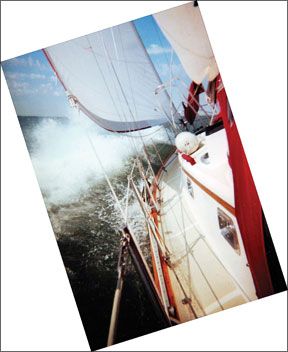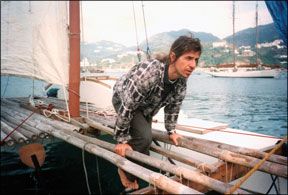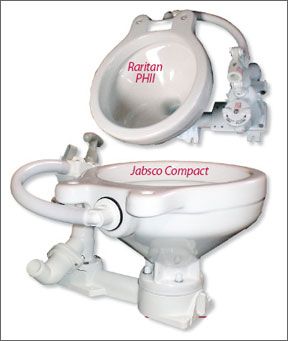Tough Boat Nominee Regarding your query about solidly built boats, I have owned (and had built) my 1981 Mariner 47, a Ted Brewer design built in E. Rochester, N.H. She is a heavily constructed fiberglass boat (about 36,000 pounds displacement) that has seen in excess of 150,000 miles of cruising under my command. During that time, I struck the side of the Cape Cod canal (solid rock) under full power because of an autopilot malfunction while I was singlehanding. Ive also struck a ledge in Portsmouth, N.H., at 12 knots (power plus current) at night when I missed an unlighted mark (again singlehanding). Ive also struck rocks in Marblehead, off Cuttyhunk, and near Rockport, Mass. None of these fiascos resulted in more than minor damage to the solid-lead keel. A similar disaster I 288 witnessed to a more lightly built boat (a Kalik 44) drove the keel up through the hull, fracturing the bulkheads and resulting in a total loss of the boat. Bob Gould Tough Boat No. 2 We are responding to your request for information as to well-built, ocean-going fiberglass sailboats. We purchased a Cabo Rico 34, new in 1990, and still own 
Mariner 47
Wellesley, Mass.
The Cabo Rico 34 is hull No. 34-11, and was the first tall tig. It has 630 square feet of sail. I think that only about 32 boats were built, so you will not hear from thousands of owners about them. It is a semi-custom boat built in Costa Rica.
The Cabo Rico 38 is also a classic bluewater cruiser built to the same standards, and there have been more than 230 built. Bill Crealock, the designer, was commissioned to do our tall rig. He said the 34 had higher margins of design safety for the rig and the hull than he normally puts into a design.
The bottom of the hull is solid fiberglass to the turn of the bilge. It is then cored from there to the deck. You rarely see the 34s for sale. Most owners are like us and tend to keep them a long time.
Fred & Barbara Jensen
Sandusky, Ohio
A number of readers responded with their nomininess for this project. We welcome more.
Dodging the Boneyard
Your article,”Lessons from the Boneyard,” (0ctober 2007) brought back a shudder of memories of Hurricane Isabel. My 43-foot Morgan,
Intuition, could have been in that picture of the Annapolis Naval Station boatyard, but as luck would have it, the yard personnel were too backed up to haul her. In the end, I rode out the storm aboard in a small cove with high banks off the Severn. I used a Mediterranean moor by dropping the best bower on the way in and making fast to a large tree ashore. Sounds easier than handling it single-handed actually was. For extra insurance, I rowed out and set the other anchor from the dinghy. The night passed relatively uneventfully, fortunately.Incidentally, some of the damage at the Naval Station was caused by large timbers breaking loose from the dock and breakwater, which washed over the sea wall and took out the jack stands supporting several of the boats. I feel very lucky to have been spared any damage, especially since the berth at the marina in town that
Intuition had occupied was well under water.Tim Russell
Annapolis, Md.
A Coastal Cat?
I enjoyed the article about the TomCat 9.7, but had one big question by the end: Why do you call it a “coastal cruising cat”? Cockpit size? Load capacity?
Structural? Other?
Ed Jones
Annapolis Md.
Via e-mail
Most of the boats we review are loosely described as either ocean voyaging, coastal cruisers, or daysailers. In our view, “coastal cruisers” are perfectly capable of short offshore passages and island hopping, where, with an experienced hand on the helm and a close eye on the weather, it is unlikely that the crew would encounter a severe gale. Various organizations-most recently the

James Baldwin
288
European Recreational Craft Directive with its Category A, Category B, etc.-have attempted to codify the distinctions between recreational boats, but this judgment also depends upon ones experience and threshold for risk. Ocean voyaging in any boat is inherently risky, and one could argue that, in the right hands, the TomCat 9.7 and other small catamarans are capable voyagers. After all, there is no shortage of sailors who have managed long, arduous ocean crossings in boats that seem less seaworthy than the TomCat 9.7. A few extreme examples come to mind: Alberto Torroba (trans-Pacific in a dugout, above), Andrew Steward (circumnavigation in a Dudley Dix-designed open boat), Webb Chiles (near circumnavigation in a Drascombe Lugger).
The short answer to your question is that design elements (including sail-area/displacement ratio, stability index, etc.), structural strength, and load-carrying capacity are key factors
Practical Sailor considers when attempting to classify a boat. Occasionally, however, the editor must fall back on the mother-in-law rule of thumb: If he has no qualms sending his mother-in-law across the North Atlantic aboard a particular boat, then it is an ocean voyager. (Yes, she would likely survive the crossing on the TomCat 9.7, but there would be hell to pay upon her return.) Certainly this is a topic worthy of serious discussion, and we welcome comment on the issue of standards for recreational boats.Electric Ooutboard
Would you please consider a review of “larger” electric outboards suitable for daysailer auxiliary propulsion? Here is a list of possible candidates: Whisper XP; Torqeedo Cruise 2.0,
www.torqeedo.com; Minn Kota 48v E-Drive, www. minnkotamotors.com; Briggs & Stratton 48v, www.briggsandstratton.com; Ray Electric, www.rayeo.com; American Marine Electric Corp., www.outboardelectric.com.Jimmy Krogen
Kady-Krogen Yachts
Stuart, Fla.
Sounds like a good follow-up to our review of the Torqeedo Travel 801 last month. Look for a comparison of these products in 2008.
Alternative Fridge
I have what I think is a viable alternative to your refrigerator solutions (May 2007), especially as they pertain to cruising itineraries of just a few days.Last year, I bought a Sanyo 110 vac 4.9-cubic-foot reefer for $200. I also bought the Xantrex XPower PowerSource 1800 (as in 1800 watts) battery/inverter for

288
$500. With that device wired to a switch that selects between my generator and my alternator for recharging (all this on a pimped-out Paceship 26), I have been at sea for up to five days at a time protecting perishables, including insulin for my wife. And, the Sanyo has a small, but adequate, freezer compartment.
My PowerSource unit also powers multiple AC devices quite handily, and at the same time.
Richard Gnci
Paceship 26
Via e-mail
Fishermans Boots
With regards to your recent article on sailing shoes (“Sailing a Sea of Shoes,” 2007), you may find the following useful. My husband and I both have wide feet. When we sailed from Honolulu to Sitka, Alaska, he wore Gill boots and I had basic West Marine yellow boots. By the time we reached our destination, we were barely able to walk-alternating between throbbing/pins & needles and numbness. We rafted next to an Alaskan fisherman who recommended XtraTuf neoprene boots (
www.xtratufboots.com), and we were hooked (pardon the pun!). These heavy-duty, lug-soled boots provide excellent support, have ample room for wide feet (or thick socks) and the sizes range from toddler to large adult. They are totally waterproof, work perfectly when landing a dinghy, and are comfortable for extended hikes. The only drawback to these boots is that the soles can collect small pebbles which can scratch the decks. So we make a habit of inspecting them as soon as we get on board. Weve sailed over 20,000 miles since discovering these boots, and theyve held up beautifully. In warm weather, I reach for my Keens (which I find preferable to Tevas and Reefs, both for support and the covered toe).Marci and Joseph Paravia
Hans Christian 38
San Diego, Calif.
Bow Chocks
I suggest you do a test of bow chocks in simulated storm/hurricane conditions. There would be several things to test, and information generated would be of significant help to all sailors. The test should include the extreme strain of storm loading, the additional shocks imposed by tacking back and forth on the mooring (the snap tacks impose much higher loads), and the strains imposed by storm waves in a harbor.
You may find as I did that the existing data on loads is all over the place. You might have to hook a load cell up to a mooring line to try to get some real world data on mooring pendant peak and on cycle loads during a storm, and maybe even use an infrared temperature gun to see if the line warms up.
Ted Cady
Warwick, Mass.
Via e-mail
A closer look at chocks for mooring and dock lines is in progress. A report on the ultimate strength of old nylon mooring or dock lines appears on page 14.
Electric Heads
I am interested in an article comparing electric heads, particularly for the small head compartments usually found in our boats. I have been doing my own research and settled on the Sealand 8812 (
www.sealandtechnology.com). I tried the Jabsco electric head conversion (www.jabsco.com) but found it to be completely unacceptable. I also considered the Tecma Easyfit (www.tecma.net), but unfortunately it didnt fit easily.Robert Olesen
Beneteau 331
Long Island, N.Y.
Many readers who responded to the our request for test suggestions recommended a comparison of marine toilets. Surprisingly, a number of people wanted to see electric heads compared. A comparison of both manual and electric heads is in the works, kicking off with a head-to-head (so to speak) endurance test between two popular units pictured below, the Raritan PHII and the Jabsco Compact.
Inexpensive Headsets
I purchased and have used a pair of the Cruising Solutions headsets you reviewed in your October issue. I agree completely with your assessment of this product as a useful alternative for those of us not on an Americas Cup type of budget. I would add one thing to your review and that is to not expect hands-free operation. The flimsy stalk that supports the microphone doesn’t do its job. The operator really needs one hand to hold the microphone close enough to the mouth in order for the thing to work. Sometimes, this weakness overcomes the convenience of the device.
Layne Carver
St. Paul, Minn.
Via e-mail
Mast Hardware Query
I have a 1978 Hunter 30 with a standard mast. I bought the Schaefer lazy jack for my size boat. What do I use to secure the mast end of the unit? Rivets, sheetmetal screws, or tap the mast for machine screws?
Bill Becker
Hunter 30
Via e-mail
According to Schaefer, the kit for a Hunter 30 should have 10-24
machine screws included. Carefully drill and tap for the machine screws. It is very important to coat the screws and holes (Schaefer recommends the jointing compound Duralac, available from Hall Spars,
Woody Wax Update
This past summer, I used Woody Wax Nonskid on the deck and cabintop of our 1999 Gozzard 37. When I washed the boat the following weekend, I had a hard time getting it clean. It seems the wax got dirty. I had to basically strip the wax off to get the boat clean. This happened both times I used the wax.
Mike Harrigan
Gozzard 37
New Buffalo, Mich.
The non-skid surface used for that test did not have the problems you describe with Woody Wax, but another reader reported a similar problem to us. We will be retesting the Woodys Wax Nonskid and will report any findings.


































